 |
| Himalayan dawn |
|---|
I’ll begin with the event that is freshest in my memory!
Charity trek in Sikkim (October-November 2008)
 |
| Good morning? |
|---|
 |
| Knackered |
|---|
As most of you know, no-one signed up to join me on this trek which I had thought would be a great way of raising funds for HELP. Well, as it turned out I wasn’t so wrong. Firstly, my eldest son Alan decided to join me, which was a boost to my rather deflated morale. Even better, we managed, between us, to raise £1280 thanks to the generosity of friends, relations and work colleagues. There may even be one or two more payments in the pipeline. Indeed, there was one mad friend, who shall remain nameless, who donated £500! Thanks Charles! And thanks to everyone else who helped me make this charity trek a success.
You wouldn’t have thought I was keen on trekking if you had been able to observe me. I found it hard going with lots of long, steep climbs, some bitterly cold nights, and, my nemesis, high altitude. There were times when we both swore we would never do such a trek again. But the scenery was fantastic, and neither of us wanted to be the first to give up! In the end, we made it to the bitter end!
The big day started at 3am and went on for another 11 hours. There are two ridges, with good views of Kanchenjunga, before you get to the Goecha La pass proper, and the great majority (more than 90% according to our guide) turn back at one of these points rather than push on to the pass, either because they are too shattered, or because their guides fool them into thinking that they have reached the pass when they haven’t. We’re pretty sure we were the only ones to make the pass that day. A Russian group, whose guide had had to accompany a client down the mountain to recover from altitude sickness, attached themselves to us, but, in spite of the piece of Kendal mint cake I gave them for sustenance, gave up at the first viewing point. So, dear sponsors, rest assured that we achieved our goal, and we suffered for it!
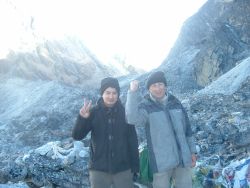 |
| Goecha La pass conquered |
|---|
I am not sure, at this stage, whether to try the charity trek idea again as a way of raising funds for HELP. Without a sufficent budget to engage in advertising in the national papers, in the manner of larger charities like Scope, I don’t think I can reach enough people to make it work well. However, Alan and I have shown that friends, relations and work colleagues will respond generously if you undertake a charity challenge on behalf of a charity.
If any of you do decide to do something that challenges you (it doesn’t have to be a trek), then please do think of using the opportunity to raise funds for HELP. I will give you as much support as I can. You can refer your supporters directly to our donations page, rather than to a specialist intermediary organisation which will deduct a fee for their services.
Donations
You don’t have to make me suffer before making a donation to HELP! My special thanks to Rosemary Watling, retiring head teacher of the Belle Vue Junior School, who passed on to me the £325 that her colleagues had collected for her retirement present. And indeed, thanks to all of you who made donations throughout the year, not least our volunteers.
Projects
St. Paul Nursery School (Sikkim)
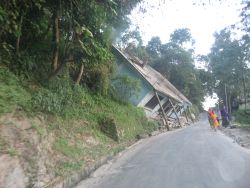 |
| Landslide |
|---|
After the exertions of the trek, I visited a number of the schools supported by HELP in Sikkim and West Bengal as I could, and was able to see how the building works at St. Paul Nursery School (Sikkim) and the J.N. Memorial Public English were progressing. The former is now complete, and came in under budget. The last updated estimate was £22,000, but only £19,000 was needed in the end. However, there are problems with landslides, and the land between the school and the road below needs shoring up. I will need to find some money to help them do this. Landlsides are a constant damger in the Himalayas, and particularly in Sikkim which has a very heavy monsoon, and hardly any flat ground to build on. The accompanying photo gives you an idea of what can happen (this is not a picture of St. Paul’s by the way!)!
J.N. Memorial Public English school (Kalimpong)
The giving and receiving of gifts, especially money, is the cause of more embarrassment and confusion and mutual misunderstanding between us westerners and our Himalayan friends than any other difference I can think of between our two cultures. The JN Memorial Public English school was housed in a flimsy wooden structure, which was slowly sliding down the mountain. Fund-raising for a new building project was initiated by Anne Tallentire, mother of Becky Scott who volunteered at the school in 2006, and Alison Stephens, with help from the staff and pupils of Hilmarton primary school, which Alison’s son attends (many thanks to all of you!). The school’s website displays pictures and news of the JN Memorial school.
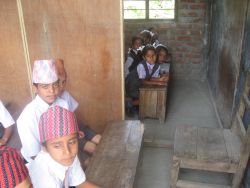 |
| Two into one at the JN Memorial |
|---|
The target for the building was of £7,000, which was the original estimate for the new structure, and by last summer, they had raised £4,000. I sent the money in instalments, and was very gratified to get a letter of thanks which stated that the work had been completed. Yet, on my recent visit, I saw that the building was far from complete. Each classroom was housing two class levels, as the accompanying pictures show. When I asked them why they had written to say that the building was complete, the answer was that they didn’t want to keep asking for money! We will resume the fund-raising in order to built a second storey on top of the structure already built.
Gyan Jhoti Primary School (Kalimpong)
This is another school that is benefiting from a link with a British school. Ann McGivern, the mother of volunteer Mairi McGivern who taught at the Gyan Jhoti school in 2007 has set up the link with Highfields School in Newark, and the staff and pupils there have been raising money for two new classrooms. Mairi went back to Kalimpong a few months ago, and did some teaching at the school, and took some photographs showing the new land that has been purchased for the proposed new classrooms.
It’s always good to hear about volunteers staying in touch with their schools, and even making return visits. Gill Williams returned this year to the Lily Garden school, where she had taught in 2006, and did some more teaching, and, after finishing her teacher training duties in Kalimpong and Gangtok (see below), Barbara Porter returned to St. Paul’s at her own expense, and ran an informal teacher training seminar for the teachers there.
Teacher Training (Kalimpong and Gangtok)
Barbara Porter’s seminars in Kalimpong and Gangtok last February went well, even if the number of participants was slightly less than she could have coped with, and strikes threatened to disrupt her programme (more of that below under ‘volunteers’), and forced her to abandon her comfortable accommodation for something rather less comfortable. Fortunately, she managed to complete her seminars without further mishap. Extracts from her report are on the HELP blog. I hope to be able to send her to Leh in Ladakh next September to do the same. The £1,200 plus that Alan and I have raised will go a long way towards covering the costs. In addition, it would be good to follow up this year’s seminars in Kalimpong and Gangtok, with a return visit, and I have asked Barbara to pencil in January 2010 for this. I am interested in using our money to provide services of this kind, and I will be giving greater priority to helping untrained local teachers to raise the standard of their teaching than to building works.
Volunteers
Compared to last year, when we were only able to send 11 volunteers, this year was a bumper year, with 19 volunteers going out. All have returned now, except one who is still working in his school in the Pokhara valley but due to leave before Christmas.
However, there have been a couple of problems this year which have detracted from what could have been the best year ever. The first problem is political unrest in the Nepali speaking districts of Darjeeling and Kalimpong, which belong to the Indian state of West Bengal. The recently formed Gorkha Mukti Morcha party has revived a long standing demand for a separate state of Gorkhaland, and this summer asked tourists to leave the district. Our volunteers in Sikkim and Kalimpong felt obliged to leave too since the only road out of the district was being blocked. The previous campaign in the ’80s led to the setting up of the Gorkha Hill Council, with limited autonomy for the region. Although it is unlikely that the GMM will achieve an independent state, a greater degree of autonomy is a possibility. We’ll have to keep our fingers crossed that the current troubles do not harm our programme next year.
The second problem arose when an attempt by one of our volunteers to extend her Sikkim permit beyond the permitted span of eight weeks alerted the Foreigner Registration Office in Gangtok to the presence of volunteers at the DPCA. Although foreigners are not supposed to work on tourist visas, even if they are volunteering and paying for their upkeep, in practice the authorities have not, until now, made an issue of the matter. The alternative is cumbersome and, in the case of Sikkim, it can take a few weeks to secure the appropriate visa. From now on, applicants for Sikkim will need to apply well in advance of their planned visit.
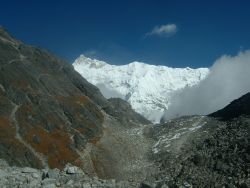 |
| Kanchenjunga from the Goecha La pass |
|---|
Apart from these upsets, most of the other assignments seemed to go very well, although one family (two adults with their two dependent adolescent children) reported that their time at the Lamdon Senior Secondary School in Leh was adversely affected by medical problems. They also reported that the requirement to prepare students for exams three weeks into their stay meant that they could not make the most of their assignment. Another volunteer felt that the school closed so often for holidays that she felt underemployed.
This kind of feedback is vital to the effective operation of our volunteer programme, and most of our volunteers are very conscientious about returning the online feedback form at the end of their assignments. This helps me fine-tune the programme, and also to provide up-to-date briefing for new volunteers.
 |
| DPCA school kitchens |
|---|
Volunteers remain central to HELP‘s activities. The schools and their children benefit greatly from the fresh approaches and enthusiasm of the volunteers (and also, as some principals have told me, from the example they set to the local teachers with regard to time-keeping and attendance). In addition, much of the money that HELP has at its disposal comes from the donations made by the volunteers when they sign up. Indeed, they often undertake tasks beyond the call of duty such as taking photos of sponsored children, monitoring HELP funded projects, inspecting schools that have approached us for assistance and so on. And, as reported above, they can inspire friends and relations to raise funds to benefit the schools they have worked at. Without the volunteers, and their contributions, we would be able to achieve very little.
What effect the current economic crisis has on recruitment next year remains to be seen. January and February are the top recruitment months. With salaried jobs being difficult to find at present, it may be that volunteering becomes an attractive option. VSO reports that their own recruitment is up for this reason.
Sponsorships
We now have 40 sponsors sponsoring 56 children (compared with a total of 20 sponsors sponsoring 28 children last year), so the programme has grown fast; faster than expected. These are sponsorships that HELP is directly managing. In addition, there are five sponsorships initiated and managed by volunteers, with payments being made through us. Many thanks to all our sponsors for the long-term commitment they have made. These payments make a big difference to the families lucky enough to benefit from them.
I always try to meet and take photos of the sponsored children on my visits to India and Nepal, and on this occasion I was able to take photos of many of the children living in or around Kalimpong, and in Sikkim.
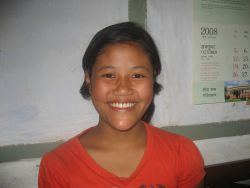 |
| A sponsored child |
|---|
Bhutan
Yami (my wife) and I visited Bhutan for a few days before returning to the UK. I can recommend it to any of you interested in visiting a quiet, untouristy corner of the Himalayas, with a unique architecture and culture. The government restricts tourist numbers by levying a hefty fee per tourist per day, so it isn’t a cheap option!
Everyclick.com
Every time you use Everyclick.com as your search engine, you can raise money for your favourite charity – like HELP for example! In an email I sent out last January, I calculated that if everyone on the mailing list used Everyclick instead of their current search engine, you would, between you, raise more than £1000 for HELP. In fact, we have raised £20 by this method over the past year! Thanks to the gallant band who helped us get there (including me!), but we could do so much better if many more of you got clicking. My experience suggests that 90% of my search needs can be met using Everyclick.com. I use Google for the rest. So why not make Everyclick your default search engine and help raise funds without any cost to you?
This is where to start: www.everyclick.com/himalayaneducationlifelineprogramme
The Blog
If you would like to keep up-to-date with what is going on throughout the year, feel free to go to our blog!
Merry Christmas to all of you, and a happy new year!
Jim Coleman
Director
Himalayan Education Lifeline Programme

Leave a comment